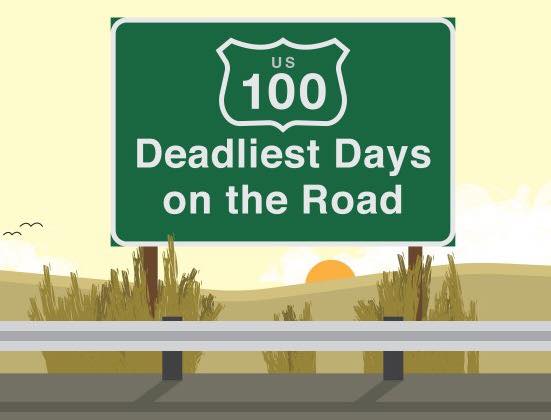“100 deadliest days” for teen drivers begin on Memorial Day

In less than a week, Memorial Day marks the start of what safety experts call the “100 Deadliest Days” — the time between Memorial Day and Labor Day when teen driver fatalities spike dramatically. But why is this stretch of summer so dangerous for young drivers?
Every year, there’s a sharp rise in auto-related deaths during the summer months, and more than 30% of all fatal crashes involving teen drivers occur during this period. With longer days, looser schedules, and more time behind the wheel, the risk multiplies.
While crash risks increase across all age groups in summer due to road trips, vacations, and higher traffic volumes, teens face additional challenges — inexperience, distractions, and often a false sense of invincibility. So what makes summer uniquely hazardous for them?
AAA, one of our trusted safety partners, sums it up in four simple words: School’s out for summer.
Parents, now’s the time to stay alert, talk to your teen about safe driving, and lead by example. These next 100 days could be the most dangerous — but also the most preventable.
Why is summer so dangerous for teen drivers?

The spike in teen driver car crashes during summer is so significant that our partner, AAA, coined a term for it: the “100 Deadliest Days.” This period — from Memorial Day to Labor Day — sees a sharp rise in fatal crashes involving teen drivers.
According to the AAA Foundation for Traffic Safety, teen crash rates surge during the summer months primarily because teens are out of school and on the road more often. Their research highlights a troubling combination: inexperience behind the wheel and increased exposure to driving situations. Together, these factors can turn summer freedom into a deadly mix.
So, how can a season known for sunshine and fun also become so dangerous?
In the colder months, teens might stay indoors for hours gaming or streaming movies. But once summer arrives, the urge to hit the road — often with friends in tow — becomes strong. Add distractions, lack of experience, and a false sense of confidence, and it’s easy to see how quickly things can go wrong.
This summer, let’s all stay aware and help keep our roads safer. Talk to your teen about responsible driving habits — and remember, a few minutes of conversation could make all the difference.
What causes dangers to rise during “100 Deadliest Days”?
Below are some more reasons why teen drivers and summer can be a deadly combination.
More free time
Think about it for a second. During the school year, your teenager probably drives to and from school during the weekdays. They may visit a friend or two over the weekend, but the bulk of their driving is going to school.
When the last bell rings to herald in the summer break, your teen driver suddenly has a lot more time on his hands. That means he or she will more likely be on the road looking for fun and adventure. This added driving time during the “100 deadliest days” is the #1 reason why teen driver dangers increase during the summer.
More passengers in the car
Your teen not only has more free time in the summer, but so do all of his buddies. A single teen passenger in a car with a teen driver increases the risk for a crash by 44 percent.
In 15% of fatal summertime crashes involving a teen driver, the driver was distracted by a passenger. So, extra passengers in the car are the #2 reason why teen drivers and summer can be a deadly combination.
Teen Driver Inexperience
Your teen is probably comfortable driving the same route to school and back home every day. In the summer, they may want to drive to the amusement or water park. Your child is not a bad driver at all, just an inexperienced one. That inexperience means they’re not always equipped to handle risks as well as older drivers.
So, while your teen driver may be tempted to hop on one of the major highways in Atlanta, it might not be the best decision if they don’t have much Interstate driving experience.
How can parents reduce risk during “100 Deadliest Days”?
The facts are in. Teen drivers and summer don’t always mix well. So, what can YOU, the concerned parent, do to help keep your teen safe? Below are a few tips from Drive Smart Georgia.
Practice Those Driving Skills
Your teen might have their license, but that doesn’t mean your new driver is ready to hop on I-85, I-285 or I-75 quite yet. Take a few practice trips with your teen on some of Atlanta’s busiest highways so that they can gain more experience and confidence before making a solo journey during the “100 deadliest days.”
Limit Nighttime Driving
The fatal crash rate for teens doubles at night. At nightfall, ordinary risks are magnified by the darkness. In Georgia, a new teen driver must have at least six hours of night driving experience before getting a driver’s license. After they have it, the state imposes a 12 midnight – 5 am curfew on drivers ages 16-17.
Follow Joshua’s Law
Joshua’s Law was passed in the state of Georgia in 2005 to help keep teen drivers safer on the road, despite a multitude of new and ever-present dangers.
So, exactly what is Joshua’s Law? What are its restrictions for teen drivers? Be sure to check out this in-depth article about the all-important law in Georgia and 16 other states. Make sure your teen driver follows it to the T, especially during the “100 deadliest days.”
Avoid All Distractions
While texting and talking on a cell phone are certainly driving distractions, there are many more to avoid. Eating and drinking, talking to passengers, grooming, finding a radio station, or using a navigation system all cause the driver to take his eyes off the road.
Make sure your new teen driver knows about ALL driver distractions and the possible consequences.
Set a Good Example
If you don’t want your teen driver to speed, then don’t do it yourself. Your new driver is still watching everything YOU do, so set a good example by putting the phone in the glove box and obeying all traffic laws.
You might not think teens watch and listen, but they do. They really do. Setting a good example is extremely important during the “100 deadliest days.”
Sign a teen driver-parent driving agreement
During the “100 deadliest days,” it’s important to address issues like nighttime driving and the number of passengers allowed in the car. Setting up driving rules and consequences not only drives safety home, but a signed contract can also add to your own peace of mind. Check out this Teen-Parent Driver Agreement from AAA.
The violations and consequences are entirely up to you. It’s important to get buy-in from your new driver. This can go a long way to ensure a safe, stress-free summer of 2024 for new teen drivers and their concerned parents – LIKE YOU!
Monitor Your Teen Driver
Stay engaged with your teen’s driving habits. A National Safety Commission survey found many parents are more inclined to loosen household driving rules during the “100 deadliest days” in the summertime.
Don’t be that parent.
CLICK HERE get our free newsletter and teen driving tips for parents!
CLICK HERE to read more Drive Smart Georgia blog posts.
Related articles:
- Drowsy driving is highly dangerous for teen drivers
- How to know when teens are ready to drive solo
- Advice for parents of teen drivers








